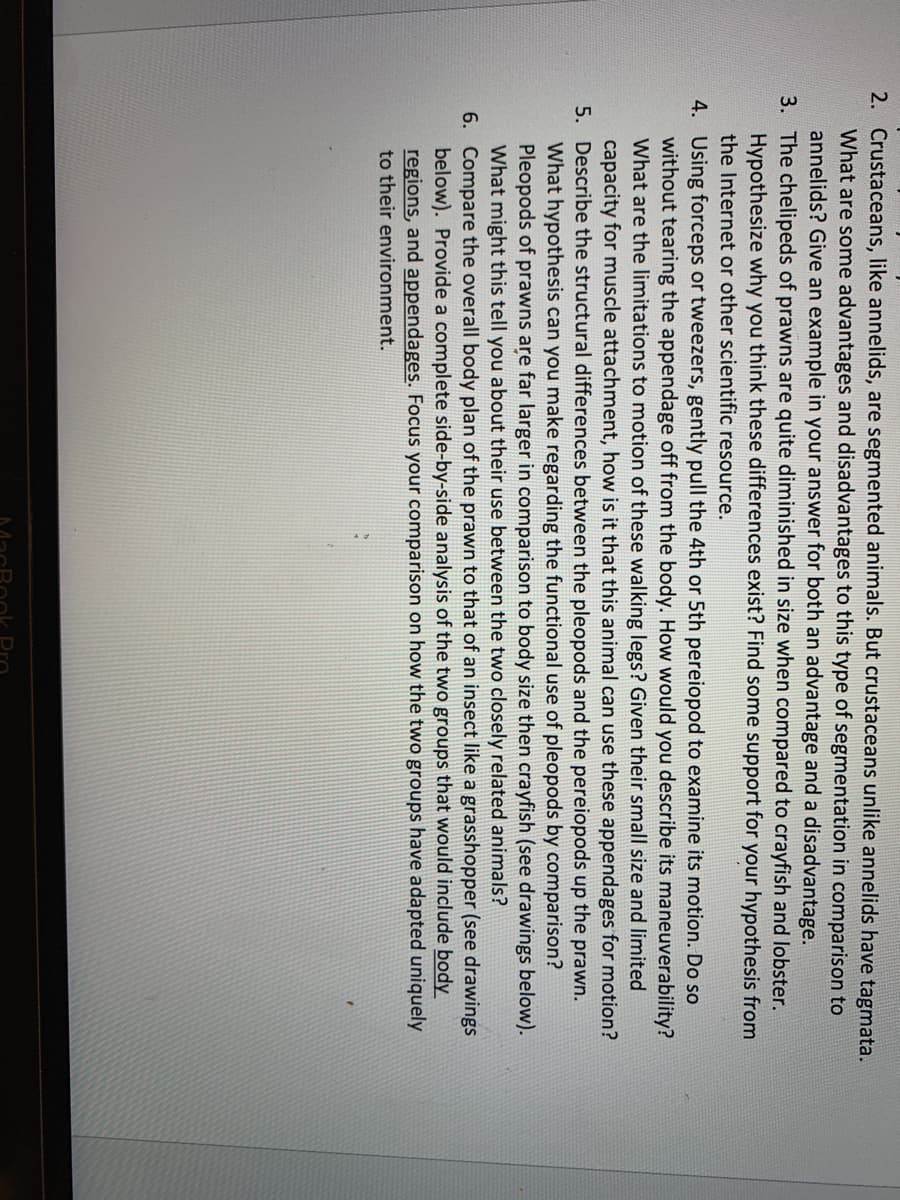2. Crustaceans, like annelids, are segmented animals. But crustaceans unlike annelids have tagmata. What are some advantages and disadvantages to this type of segmentation in comparison to annelids? Give an example in your answer for both an advantage and a disadvantage. 3. The chelipeds of prawns are quite diminished in size when compared to crayfish and lobster. Hypothesize why you think these differences exist? Find some support for your hypothesis from the Internet or other scientific resource. 4. Using forceps or tweezers, gently pull the 4th or 5th pereiopod to examine its motion. Do so without tearing the appendage off from the body. How would you describe its maneuverability? What are the limitations to motion of these walking legs? Given their small size and limited capacity for muscle attachment, how is it that this animal can use these appendages for motion? 5. Describe the structural differences between the pleopods and the pereiopods up the prawn. What hypothesis can you make regarding the functional use of pleopods by comparison? Pleopods of prawns are far larger in comparison to body size then crayfish (see drawings below). What might this tell you about their use between the two closely related animals? 6. Compare the overall body plan of the prawn to that of an insect like a grasshopper (see drawings below). Provide a complete side-by-side analysis of the two groups that would include body regions, and appendages. Focus your comparison on how the two groups have adapted uniquely to their environment.
2. Crustaceans, like annelids, are segmented animals. But crustaceans unlike annelids have tagmata. What are some advantages and disadvantages to this type of segmentation in comparison to annelids? Give an example in your answer for both an advantage and a disadvantage. 3. The chelipeds of prawns are quite diminished in size when compared to crayfish and lobster. Hypothesize why you think these differences exist? Find some support for your hypothesis from the Internet or other scientific resource. 4. Using forceps or tweezers, gently pull the 4th or 5th pereiopod to examine its motion. Do so without tearing the appendage off from the body. How would you describe its maneuverability? What are the limitations to motion of these walking legs? Given their small size and limited capacity for muscle attachment, how is it that this animal can use these appendages for motion? 5. Describe the structural differences between the pleopods and the pereiopods up the prawn. What hypothesis can you make regarding the functional use of pleopods by comparison? Pleopods of prawns are far larger in comparison to body size then crayfish (see drawings below). What might this tell you about their use between the two closely related animals? 6. Compare the overall body plan of the prawn to that of an insect like a grasshopper (see drawings below). Provide a complete side-by-side analysis of the two groups that would include body regions, and appendages. Focus your comparison on how the two groups have adapted uniquely to their environment.
Biology (MindTap Course List)
11th Edition
ISBN:9781337392938
Author:Eldra Solomon, Charles Martin, Diana W. Martin, Linda R. Berg
Publisher:Eldra Solomon, Charles Martin, Diana W. Martin, Linda R. Berg
Chapter32: The Deuterostomes
Section: Chapter Questions
Problem 2TYU: Test Your Understanding 2.Which of the following is/are found in tunicates? (a) dorsal, tubular...
Related questions
Question

Transcribed Image Text:2. Crustaceans, like annelids, are segmented animals. But crustaceans unlike annelids have tagmata.
What are some advantages and disadvantages to this type of segmentation in comparison to
annelids? Give an example in your answer for both an advantage and a disadvantage.
3. The chelipeds of prawns are quite diminished in size when compared to crayfish and lobster.
Hypothesize why you think these differences exist? Find some support for your hypothesis from
the Internet or other scientific resource.
4. Using forceps or tweezers, gently pull the 4th or 5th pereiopod to examine its motion. Do so
without tearing the appendage off from the body. How would you describe its maneuverability?
What are the limitations to motion of these walking legs? Given their small size and limited
capacity for muscle attachment, how is it that this animal can use these appendages for motion?
5. Describe the structural differences between the pleopods and the pereiopods up the prawn.
What hypothesis can you make regarding the functional use of pleopods by comparison?
Pleopods of prawns are far larger in comparison to body size then crayfish (see drawings below).
What might this tell you about their use between the two closely related animals?
6. Compare the overall body plan of the prawn to that of an insect like a grasshopper (see drawings
below). Provide a complete side-by-side analysis of the two groups that would include body
regions, and appendages. Focus your comparison on how the two groups have adapted uniquely
to their environment.
Expert Solution
This question has been solved!
Explore an expertly crafted, step-by-step solution for a thorough understanding of key concepts.
This is a popular solution!
Trending now
This is a popular solution!
Step by step
Solved in 2 steps

Knowledge Booster
Learn more about
Need a deep-dive on the concept behind this application? Look no further. Learn more about this topic, biology and related others by exploring similar questions and additional content below.Recommended textbooks for you

Biology (MindTap Course List)
Biology
ISBN:
9781337392938
Author:
Eldra Solomon, Charles Martin, Diana W. Martin, Linda R. Berg
Publisher:
Cengage Learning

Biology: The Dynamic Science (MindTap Course List)
Biology
ISBN:
9781305389892
Author:
Peter J. Russell, Paul E. Hertz, Beverly McMillan
Publisher:
Cengage Learning


Biology (MindTap Course List)
Biology
ISBN:
9781337392938
Author:
Eldra Solomon, Charles Martin, Diana W. Martin, Linda R. Berg
Publisher:
Cengage Learning

Biology: The Dynamic Science (MindTap Course List)
Biology
ISBN:
9781305389892
Author:
Peter J. Russell, Paul E. Hertz, Beverly McMillan
Publisher:
Cengage Learning
